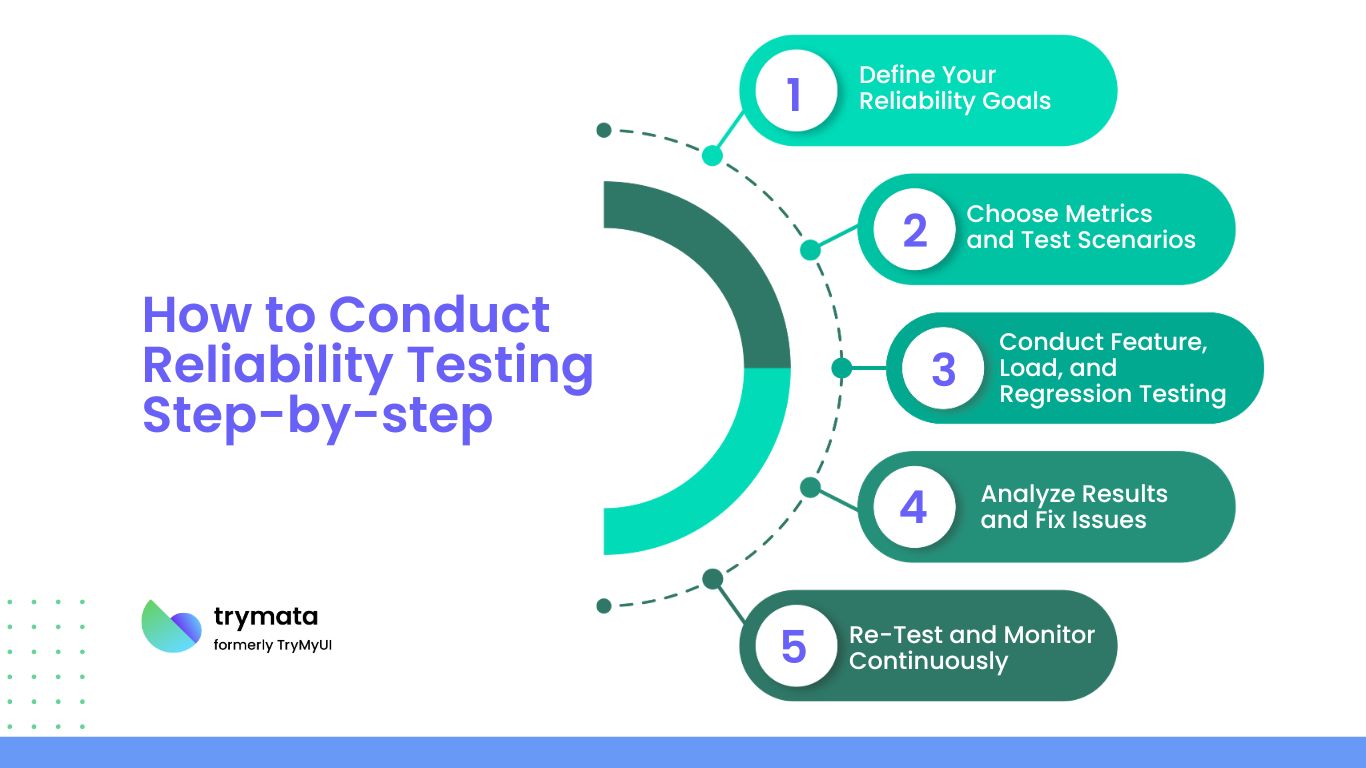When you use a product, nothing is more frustrating than features that work sometimes but fail at other times. Imagine trying to make a payment, submit a form, or log in, only to run into random errors. That’s exactly why reliability testing is crucial. It’s all about ensuring your product works consistently and predictably for every user, every time.
In this blog, we’ll walk you through what reliability testing is, why it matters, the key types you need to know, and a simple step-by-step process to conduct it effectively. By following these steps, you’ll learn how to make your product dependable, smooth, and enjoyable for users every single time they interact with it.
What is Reliability Testing?
Reliability testing is about making sure your product or system is dependable. In simple terms, it’s the process of checking if a product performs the same way every time under the same conditions. For example, if users try to complete a task on your app, like making a payment or filling out a form, you’d expect them to get the same result each time without random errors or failures.
In usability testing, reliability testing focuses on consistency in the user experience. It’s not just about whether the product works once, but whether it keeps working correctly for different users, on different devices, and over repeated attempts. If a product passes reliability testing, you can trust that it will behave predictably, giving users confidence and reducing frustration.
At its core, reliability testing answers a simple question:
“Can users rely on this product to work properly every time they use it?”
Importance of Reliability Testing
When you’re running usability tests, it’s not enough to know if your product works once. What really matters is whether it works every single time. That’s where reliability testing comes in. It’s the part of usability testing that checks if your product is consistent, dependable, and trustworthy for users in the long run.
Here’s why reliability testing is so important:
- Builds user trust: When your product works the same way every time, users feel confident relying on it.
- Reduces errors: Consistent performance means fewer unexpected bugs or failures during tasks.
- Improves user experience: A reliable system makes interactions smoother and less frustrating.
- Supports repeat usage: If users know they can depend on your product, they’re more likely to keep coming back.
- Strengthens brand reputation: Reliability reflects directly on how professional and credible your product feels.
At the end of the day, reliability testing is about giving users peace of mind. It ensures that no matter when or how they interact with your product, the experience stays stable and predictable. And in usability testing or software testing, that kind of consistency is what separates a product people enjoy using from one they quickly abandon.
Types of Reliability Testing
When you’re checking how reliable a product really is, there are a few different ways to test it. Each type focuses on a specific part of the user experience, and together they give you a clear picture of how dependable your product will be. Let’s look at three common ones:
1. Feature Testing
Think of this as checking if every feature in your product actually works the way it’s supposed to.
For example, in an app, you might test whether the login button always takes users to the right place or whether the “add to cart” option works smoothly every time. If even one feature is unreliable, it can ruin the entire experience for your users.
2. Load Testing
Now imagine a lot of people using your product at the same time. Will it still work properly, or will it crash under pressure? Load testing helps you find that out. In usability testing, this is about making sure your app or website stays consistent even during peak hours because users don’t care how many others are online; they just expect it to work.
3. Regression Testing
Whenever you make updates or fix bugs, there’s always a risk that something else might break. Regression testing makes sure that doesn’t happen. It’s about checking whether the product still performs reliably after changes.
For example, if you improve the checkout process on an e-commerce site, you’ll also test to ensure that payment options, order tracking, and account features still work as before.
By using these types of reliability testing, you’re not just proving that your product works—you’re proving that it keeps working, no matter what. And in usability testing, that’s the kind of assurance that builds user trust and long-term satisfaction.
How to Conduct Reliability Testing? Step-by-Step Guide
When you’re designing a product or improving an existing one, one of the biggest questions you need to ask is: Can users rely on it to work every single time? That’s what reliability testing is all about.

It’s not enough for a feature or system to work once; it needs to perform consistently across different users, devices, and scenarios. Reliability testing helps you catch inconsistencies before your users do, creating a smoother and more trustworthy experience. Let’s walk through how you can conduct software reliability testing step by step.
Step 1: Define Your Reliability Goals
Before you begin, decide what reliability means for your product. Ask yourself: Which tasks must succeed every time for the user experience to stay smooth?
Examples:
- Login should work without errors 100% of the time.
- The checkout process should complete successfully in under 2 minutes.
Clear goals give you a benchmark to measure reliability and know what counts as a success.
Step 2: Choose Metrics and Test Scenarios
Next, decide how you’ll measure reliability. Metrics give you tangible evidence of consistency and highlight areas that need improvement.
Common metrics include:
- Task success rate
- Error rate
- Time on task consistency
- Crash or downtime frequency
Pick the user flows or scenarios to test, focusing on critical actions like signing up, making payments, or submitting forms. These are the interactions that matter most to your users.
Step 3: Conduct Feature, Load, and Regression Testing
Now it’s time to get hands-on with your product. Reliability testing usually involves three main types:
- Feature Testing: Make sure each feature works correctly every time. For example, can users add items to their cart multiple times without errors?
- Load Testing: Test how your product handles multiple users at once. Will the system slow down or crash if many people are online simultaneously?
- Regression Testing: After updates or bug fixes, re-test previous features to make sure nothing that was working has broken.
By covering these three areas, you get a clear picture of how reliable your product really is.
Step 4: Analyze Results and Fix Issues
After testing, look at your results carefully. Identify patterns of failure, inconsistencies, or errors that users encounter. Prioritize fixes based on severity and frequency. A feature that consistently fails is more urgent than a minor design glitch.
Document each issue with steps to reproduce, screenshots, and logs. This makes it easier for your team to address them efficiently.
Step 5: Re-Test and Monitor Continuously
Reliability testing doesn’t end after one round. After making fixes, you need to re-test to confirm that the issues have been resolved.
- Run the same tests again under the same conditions.
- Incorporate reliability checks into your regular workflow, especially after updates or new releases.
- Monitor key metrics over time to catch new issues before they affect users.
Continuous testing ensures your product remains dependable, giving users confidence and trust in every interaction.
Metrics to Follow in Reliability Testing
When running reliability testing, you need metrics to measure how well your system performs. These act like scorecards, showing strengths and areas to improve.
- Mean Time Between Failures (MTBF)
This tells you how long your system runs before it fails. If the number is higher, it means your product is more reliable. For example, if a server runs smoothly for 500 hours before breaking down, that’s your MTBF. - Mean Time To Repair (MTTR)
When something does fail, how long does it take to fix it? That’s MTTR. Shorter repair times show that your team can quickly recover and keep users happy. - Failure Rate
This is the frequency of failures over a certain period. The lower the failure rate, the better. It helps you see patterns and spot weak points in your system. - Availability
Availability shows how often your system is up and running versus being down. If your product is available 99.9% of the time, users will trust it more. - Defect Density
This looks at the number of bugs or errors compared to the size of your software. It’s a good way to measure overall quality.
By keeping an eye on these metrics, you get a clear picture of how reliable your product really is. It’s like tracking your fitness progress; you don’t just work out, you also measure results to see if you’re getting stronger.
Real World Example of Reliability Testing
Let’s make reliability testing more practical with a real-world example. Imagine you’re using a mobile banking app. You expect it to work every time you log in, transfer money, or check your balance. Now, what if the app crashes every third login or fails when too many people use it at once? That’s where reliability testing helps.
In this case, the development team would test the app under different conditions:
- Feature testing: Checking if all features (like money transfer, bill payment, and balance check) work consistently.
- Load testing: Seeing how the app performs when thousands of people are logged in at the same time.
- Regression testing: Making sure that when new features (like biometric login) are added, older ones don’t break.
This type of testing helps the bank ensure that you can trust the app, no matter the time of day or number of users online. Without it, customers might lose trust and switch to a competitor.
Best Practices for Reliability Testing
If you want your reliability testing to actually work for you, following some best practices can save you a lot of headaches. Here’s what you should keep in mind:
- Involve cross-functional teams: Don’t leave testing just to developers. Bring in QA, product managers, and even customer support to spot issues from different angles.
- Document everything: Keep a clear record of test plans, conditions, and results. This way, if something breaks later, you can trace it back and fix it faster.
- Use a mix of testing tools: Relying on one tool limits your insight. Combine performance monitoring, automated scripts, and real-user data for a fuller picture.
- Prioritize user scenarios: Instead of random tests, think about how your users actually use the product and design tests around those behaviors.
- Learn from past failures: If you’ve faced crashes or downtime before, don’t ignore them. Use those lessons to strengthen your current testing strategy.
By following these practices, you’ll build a product that not only works but also earns your users’ trust. After all, nothing frustrates people more than a tool that fails when they need it most.
How to Conduct Reliability Testing With Trymata?
When it comes to usability and reliability testing, Trymata is a tool designed to make the testing process easier, faster, and more accurate. Here’s how it helps you ensure your product works consistently for every user:
- Real User Testing Across Scenarios
Trymata lets you test your product with real users performing real tasks. This helps you see how features behave in actual usage conditions. By observing multiple users across different devices and situations, you can identify inconsistencies and ensure reliability for everyone. - Video Recording and Task Analytics
With Trymata, every user interaction is recorded. You can watch exactly how users complete tasks, where they face errors, or if something behaves unexpectedly. Task analytics show success rates, completion times, and patterns of failure, giving you clear data on reliability. - Quick Identification of Bugs and Failures
Since you can see detailed user behavior, Trymata makes it easy to spot where a feature fails or behaves inconsistently. Whether it’s a login button that works for some users but not others, or a form that sometimes crashes, you get precise evidence to fix it quickly. - Test Repetition Made Simple
Reliability testing is all about repeatability. Trymata allows you to rerun the same test with multiple participants or after product updates. This way, you can confirm that issues have been fixed and that features remain consistent over time. - Centralized Data for Better Decision-Making
Trymata organizes all the recordings, metrics, and user feedback in one place. This makes it easier to analyze patterns, compare test results across sessions, and make data-driven decisions to improve your product’s reliability.
Conclusion
Reliability testing is more than just a technical check; it’s about building trust with your users. By ensuring your product works consistently, every time, you create a smoother, more enjoyable experience that keeps users coming back.
From defining clear goals to measuring performance, testing critical features, analyzing results, and continuously re-testing, each step plays a vital role in making your product dependable. A reliable product doesn’t just reduce errors, it boosts user confidence, strengthens your brand, and sets your product apart in a competitive market.
Tools like Trymata can make reliability testing even easier. With real user testing, video recordings, and task analytics, Trymata helps you quickly spot inconsistencies, track performance, and ensure your product works reliably across different users and scenarios. Using such tools saves time and gives you actionable insights to improve your product’s consistency and user experience.




